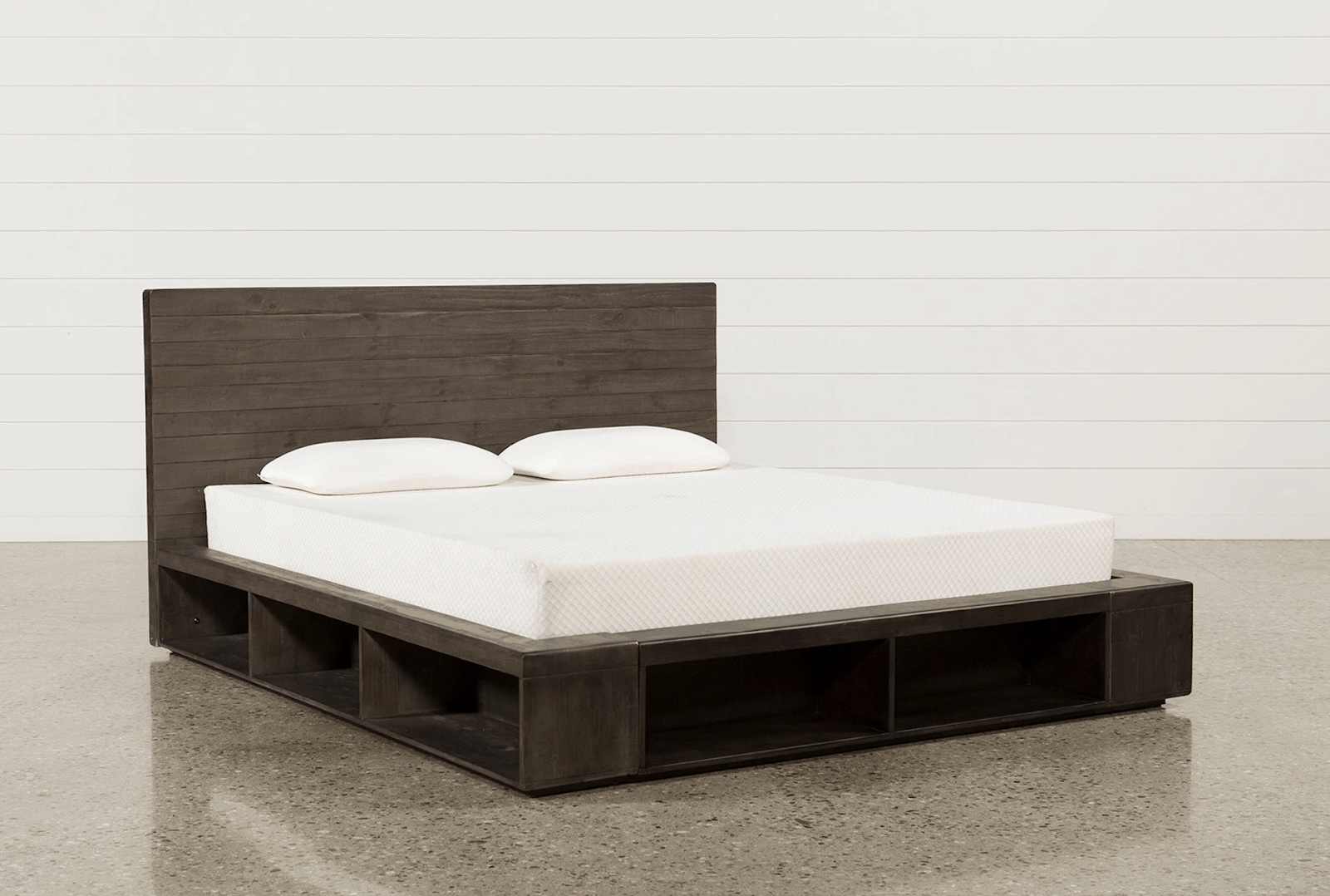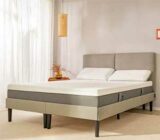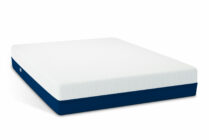Platform beds are the most popular choice among today’s families and there are solid reasons for that. They are very versatile, giving you the option of having an attached shelf or an under-bed storage drawer. They are also sturdy, easy to disassemble for transport and can bring a modern look to the bedroom.
There are five types of mattresses for a platform bed that you can choose from including: thick memory foam mattresses, thin memory foam mattresses, latex foam mattresses, innerspring mattresses, and hybrid mattresses.
Our 3 favorite mattresses for plateform beds
What manufacturers specify about a mattress such as “firmness” isn’t what you may feel when you try out the mattress. However, knowing what factors affect the overall sleeping experience of a mattress will give you the necessary knowledge to shortlist a handful of mattresses to pick from.
In the following post, we showcase the different types of mattresses available on the market, what type of mattress you need for a platform bed, and tips on selecting that perfect mattress made just for you and your family.
Related topics:
Types of Mattresses for Platform Beds and their Advantages & Disadvantages
Platform beds can take the same type of mattresses as any other frame which means that you have a wide variety of mattress to choose from.
Mattresses come manufactured in different kinds of material with each material having its own advantages and disadvantages. The most common types are Memory foam, Latex foam, Inner-spring and Hybrid mattresses.
The material of the mattress together with the thickness of the mattress determine how supportive you’ll feel and whether you’ll be warm or cool during sleep.
Also, each manufacturer varies the thickness or arrangement of foam layers inside the mattress so that two mattresses made of the same material with the same thickness can feel totally different when you sleep on them.
Mattress material type defines whether you’ll bounce or sink in your bed. Firm mattresses with a lot of bounce are suitable for those who need good support during sleep, though doctors recommend not going too firm, as it might negatively impact the quality of your sleep. Firm mattresses are good for back sleepers, older adults, people with spinal / back issues and those recovering from surgery. Are platform beds good for back pain? Read more here.
Beds with good support ensure that the body weight is evenly distributed and no particular area is over-stressed.
Bed with low firmness and added thickness tend to be soft and cozy to sleep on. This is especially suitable for side sleepers since their shoulders can sink-in to the bed, avoiding stress concentration.
The material & construction of the mattress also determines whether you’ll feel hot or cold during sleep. Some mattresses dissipate heat quickly while other types tend to retain heat for a longer period. It all depends on what you need for your current situation. If you want your bed to feel warm and cozy throughout the night, you should pick a mattress with low ventilation. If you live in hot and humid weather, you’ll definitely need a lot of ventilation on your mattress to keep it both cool and dry.
Check out the table below to see how various mattress types compare when used in a platform bed.
| Mattress Type | Advantages with regard to a platform bed | Disadvantages with regard to a platform bed |
| Thick Memory Foam | With a low profile platform bed, you can enjoy a cozy sleep without finding it troublesome to get in and out. | If you choose a platform bed with storage space, you’re likely to find the bed a bit too tall to climb on to (because the mattress is thick and tall). |
| Thinner Memory Foam | You can use a tall platform bed with a lot of storage space and lay a thin memory foam layer on top (making it easy to get in and out). A thin memory foam layer works well with plywood instead of slats. Check the mattress ventilation requirements. |
Not suitable for platform beds with slats as they tend to push through the gaps between the slats. You might feel the bumps of the slats when sleeping. |
| Latex Foam | Can be used on platform beds with slats to keep you cool. Great for warm sleepers. | May feel too firm as platform beds provide a solid base. |
| Innerspring | Can be used to increase the bed height in case you have a low profile platform bed | Too bulky to more around and adds a lot of height for a standard platform bed |
| Hybrid | Offers more softness over an innerspring mattress with reduced thickness. | Considerably heavier and pricier than other material types. |
Make sure to also take a look at our article, should you fold a mattress in half to move it, for more useful information. Also, if you already have an old mattress that you want to use with your platform bed, you might find some interesting information in how to choose a mattress topper to fix a lumpy mattress too.
Make sure to also take a look at our step by step guide on how to move a platform bed as well. This article will give you loads of useful tips for getting your platform bed exactly where you want it to be.
Tips for Selecting a Good Mattress for a Platform Bed
Tip 1: Use a measuring tape and figure out the ideal height that you want your bed to have before deciding on the mattress thickness.
Measured from the floor, these are the ballpark measurements for optimum bed height:
Kids: 18” – 22”
Adults: 24” – 35”
Older adults and those using wheelchairs: 20” – 23”
If the bed is to be used by a person with a disability, make sure that the bed height is at the same height-level as their wheelchair. This will ensure an easy transition between the bed and the chair.
Tip 2: Choose a mattress material based on your sleeping position, ventilation needs and durability
| Type of Mattress for Platform Bed | What Sleeper is it ideal for? | Ventilation (out of 5) | Durability (out of 5) |
| Memory Foam | Side sleepers, Tummy sleepers | 2/5 | 4/5 |
| Latex Foam | Back sleepers | 5/5 | 4/5 |
| Innerspring | Back sleepers, Tummy sleepers | 4/5 | 3/5 |
| Hybrid | Side sleepers, Back sleepers, Tummy sleepers | 4/5 | 3/5 |
Tip 3: Always keep in mind that slat type platforms offer good ventilation while plywood board platforms offer very low ventilation.
Tip 4: As much as possible, physically try out a mattress before purchasing it.
What feels soft to someone may feel firm for you and vice versa. And as discussed earlier, the body weight of the person sleeping on the bed also influences the sleep quality.
So it is always wise to first shortlist your top 3 choices and go check them out physically at a store or a friend’s place before placing an order online.
What mattress sizes and thicknesses are needed for platform beds?
You don’t need any specific mattress size or thickness for a generic platform bed because they are able to fit any mattress. However, you may not be able to find many platform beds for uncommon mattresses sizes such as Full XL. Also, the thickness of mattress you choose should depend on whether you get a low-profile or standard platform bed height.
A suitable platform bed can be found for all standard sizes of mattresses which include Twin, Twin XL, Double, Full, Full XL, Queen, Eastern King and Cal King. Read more about Platform Bed Mattress Sizes.
Depending on whether the platform bed has a head-board, foot-board or storage area, the overall size of a platform bed can vary from model to model.
In most cases, you will be able find the suitable mattress size mentioned on the platform bed’s user guide.
Although most mattresses are available in all the aforementioned sizes, it is harder to find platform beds with all the different sizes.
There are some bed sizes which are more popular than other sizes (and some are extremely rare like the Full XL). The more popular a mattress size is, the more the variety of platform beds that are available for you to choose from.
Twin, Queen and King sizes are more common and hence you’ll find a lot of beds suitable for them whereas you’ll find it hard to see more variety for the remaining sizes.
Therefore it is always better that you first choose a suitable platform bed size and model before looking for a suitable mattress.
Apart from the bed size, the height of the platform bed will hugely impact the type of mattress that will be suitable for it. Low profile platform beds are usually preferred for their minimalistic looks and high profile platform beds are often desired for the luxurious feel that they give to the bedroom.
Depending on whether you choose a low profile or a high profile bed, the suitable thickness of the mattress will vary significantly.
The problem with low profile platform beds is that they are harder to get in and out especially for people with back or knee problems. To sort this out, you’ll need to use a thicker mattress to compensate for the low platform height thus obtaining an overall bed height which is high enough to easily get in and out.
You can use the opposite of this in a high platform bed where using a thinner mattress will help keep the overall bed height low in order to be accessible to kids and pets.
Mattresses which have a thickness of above 14” can be used on low profile beds to increase the bed height. Be aware that the increased thickness will cause the mattress to feel soft and less supportive especially if you choose a memory foam mattress. If you prefer firmness, you can go for either a less thick memory foam mattress 10-12” or switch to a latex foam or an innerspring mattress to get a more firmness from the mattress.
As a general rule, you can expect mattresses below 12” to be more firm and above 14” to be softer.
Mattresses having thickness less than 8” may be inexpensive but they won’t have enough foundation to support your body weight over a period of time. You can expect them to form pockets or collapse in areas within a few years of use.
Related topics:
- Orthopedic mattresses and how they help seniors sleep in platform beds
Summary
In summary, choose a mattress type that will provide you adequate support, cool or heat your body (depending on your requirements), and choose a thickness that will give you enough comfort and the ability to get in and out of bed easily.
Now that you’ve got your head around how these factors affect a mattress, you’ll be able find the perfect mattress you and your family in no time!




